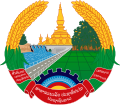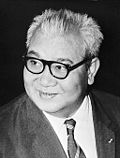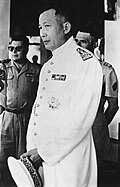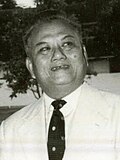Pre-constitutional period (1975–91)
The Lao People's Democratic Republic (Lao PDR) and the office of prime minister were established on 2 December 1975 by a decision of the National Congress of People's Representatives (NCPR). All institutions of the Kingdom of Laos were replaced with institutions strongly influenced by those in other socialist states, especially Vietnam. The NCP ordered the Supreme People's Assembly to "propel, assist and control all the activities of the government, to prepare a draft Constitution as well as propose laws which are indispensable and to strengthen the base of the new code of the law of the People's Democratic regime". The NCPR also gave the Lao People's Revolutionary Party (LPRP) a monopoly on state power. The Prime Minister, the government and the SPA (the new legislature) would implement party decisions. Lao People's Revolutionary Party general secretary Kaysone Phomvihane said in 1977, "Party committees at all levels must lead [in fulfilling] the revolutionary task in all domains, but the essential is to direct the power of the state. They must make [the state] secure and powerful, capable of applying the line and policies of the Party." According to scholar Chou Norindr, the political system made the government and legislature subordinate to the party. This contrasts with liberal democratic societies, in which several parties compete for power and all are subject to state laws.
The governmental structure established on 2 December 1975 was named the Council of Government, like its Vietnamese counterpart. The council was responsible for the political, economic, cultural and social affairs of the state, and its security, defence and foreign relations. It was also responsible for increasing the state's economic performance, developing collective power and establishing a socialist mode of production. The Council of Government was the supreme power in administration and economic affairs.
The government had a hierarchy since its inception. Kaysone Phomvihane, the first prime minister of the Lao PDR, also served as LPRP general secretary and a member of the Politburo and Secretariat. His four deputy prime ministers (Nouhak Phoumsavanh, Phoumi Vongvichit, Khamtai Siphandon and Phoune Sipraseuth) served concurrently in the LPRP Politburo, the highest decision-making body between Central Committee meetings. Below them were members of the LPRP Central Committee and other party members. The presidency of the Council of Government, the highest governmental body, was composed of the prime minister, his deputies, and Saly Vongkhamsao, Sisavath Keobounphanh, Chanmy Douangboudy, Maychantane Sengmany and Thongsavat Khaykhamphitoune. Members of the presidency controlled the state's legislative, executive and judicial powers. The First Government's deputy prime ministers had wide-ranging responsibilities; they led their respective ministries and oversaw other ministries on behalf of the Prime Minister. With the Prime Minister, The First Government and prime minister reported their activities to the SPA (consisting mainly of LPRP members), which rarely held the government accountable.
The assembly passed the Law on the Council of Government, which stated that the Council of Government has the "full power to settle all matters of state management which do not fall under the duties and rights of the Supreme People's Assembly and the SPA Standing Committee", in November 1982. The law changed the prime minister's title to Chairman of the Council of Government, and the deputy prime ministers' to deputy chairmen of the Council of Government. It intended to strengthen the body's collegiality by emphasising collective leadership, a communist leadership principle which seeks to minimise arbitrary decision-making; "representatives of trade unions, youth and women may be invited" to the meetings of the Council of Government "for consultation on problems involving the masses of all strata to which each organisation is responsible". Ministers could also attend council meetings.
The Council of Government organised quarterly meetings of all ministers; between sessions of the Council of Government, the Standing Committee of the Council of Government met weekly. It was composed of the chairman, the first deputy chairman, deputy chairs, ministers and the head of the Office of Council of Government. The first deputy chairman acted for the chairman in his absence. The deputy chairmen, as before, supervised and coordinated the activities of ministries and governmental committees. Decrees, decisions and significant issues decided by the Council of Government (or its standing committee) had to be signed by the chairman to become effective; resolutions, decisions and instructions issued on less-critical matters could be signed by the chairman or first vice-chairman. One section of the law was devoted to the Office of the Council of Government, which was responsible for preparing the council's work, organising its meetings and implementing its decisions. The head of the Office of the Council of Government reported to the chairman and first deputy chairman, working on behalf of the council with the SPA and other organisations.
The absence of a constitution influenced Laos' institutions. Souphanouvong, the Chairman of the SPA Standing Committee, was elected Chairman of the SPA Constitutional Drafting Commission. Between 1975 and 1984, however, none of its work was made public. In 1984, the SPA announced the creation of two subcommittees of the Constitutional Drafting Commission. The lack of an institutionalised structure led the party to bypass state structures in decision-making; the LPRP Secretariat, for example, bypassed the SPA. It reshuffled the First Government in January 1982, in violation of the law. No explanation has been given for why it took so long to write a constitution; Vietnam approved a constitution four years after reunification, and the People's Republic of Kampuchea took two. Laos, influenced by reforms in Vietnam and the rest of the socialist world by the mid-1980s, called for SPA elections in 1988. At the assembly's first plenary session, party leaders reported that the draft constitution was nearly finished. On 14 August 1991, the SPA adopted the first constitution of the Lao People's Democratic Republic.
Constitutional system (1991–present)
The new constitution changed the chairman of the Council of Government back to prime minister. It affirmed the LPRP's role, defining it as the "leading nucleus" of the state. The government's executive branch was strengthened. The Prime Minister's power was reduced, and the president's was increased; the Prime Minister had appointed provincial governors, but the president did under the new constitution. The President now had the right to appoint and dismiss the Prime Minister and ministers in accordance with the National Assembly. According to scholar Stephen T. Johnson, the new presidency was comparable to the President of France during the Fifth Republic. The prime minister was responsible for guiding the work of government ministries, committees, provincial governors and mayors.
The constitution was amended in 2013 and 2015. Amendments in 2013 were needed to "reflect the political and economic reality of contemporary Laos", and in 2015 it was amended to "respond to the Party's renovation policies and the country's development vision until 2030". The 2015 amendments gave the National Assembly the power to appoint and dismiss the prime minister and the government, removing from the president the power to appoint the prime minister.
























